On Friday evening, Sept. 12, Monica and I arrived in Nashville, TN, for our weekend mini-vacation. We met three of Monica’s friends for dinner at Corky’s Barbecue and then returned to our motel, being too tired from the drive for any further night-time outings. I did not sleep well, for our motel was across the street from a rail-yard. Not feeling rested the following morning, I was not in a fun, “vacationy” mood. After breakfast, we perused a tourist’s guide to Nashville for ideas of sights to see. As Nashville has promoted itself for over a century as “The Athens of the South”, I figured the purple square on the map marked, “The Parthenon” would be a nice stop for the first-time tourist. Little was I expecting to be awestruck by a faithful, scholarly representation of one of history’s greatest artistic and architectural marvels.
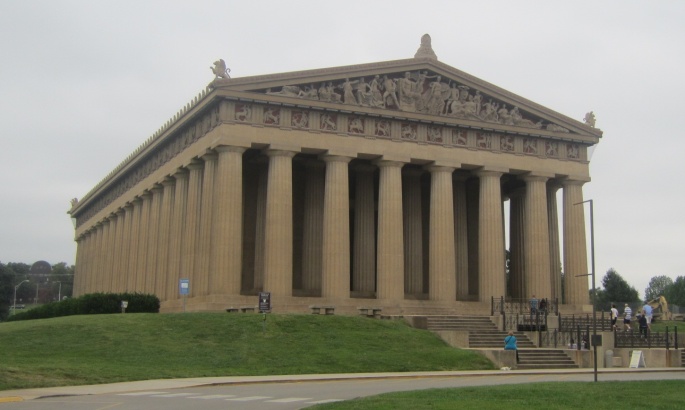
The tan colonnaded structure of the Parthenon replica stands in the center of Nashville’s Centennial Park. I did not realize it’s grand size until I noticed how small the people appeared climbing its steps. As impresssive as it is today, the Nashville Parthenon has a rather kitschy history. It was built as a temporary structure in 1897 for the Tennessee Centennial and International Exposition to house the art exhibition. Made of brick, wood lath, and plaster, the Parthenon replica was no more able to endure years of weathering than a giant wedding cake! During the 1920’s the Parthenon was reconstructed with permanent materials. In addition to bolstering the structure, gifted art scholars reconstructed the sculptures on the east and west pediments of the temple based upon sketches from Renaissance artists.
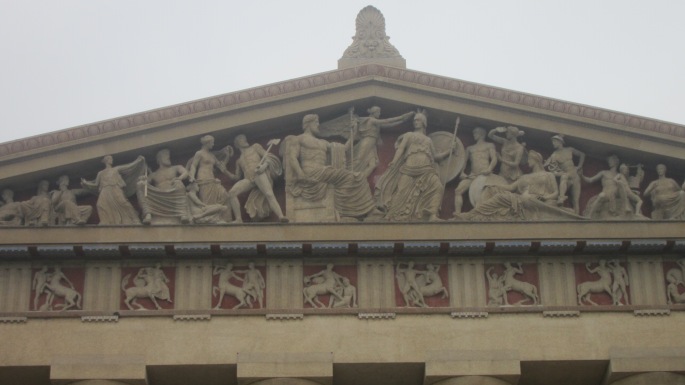
Though the outside of the Nashville Parthenon made quite an impression on me, the wondrous presence illuminating the building’s inner space was magnificent beyond any work of art I’ve ever seen. Athena Parthenos, i.e., the Virgin Goddess of Wisdom, stands over forty feet nearly to ceiling of the Parthenon’s sanctuary. Her helmet, breastplate, chiton-dress, jewelry, and weapons are gold-plated, lending a celestial radiance to the entire inner space. The skin of her face, arms, and toes are of gypsum cement, simulating the ivory of the original Athena Parthenos made in the 5th century BCE. Nike, Goddess of Victory, whom the colossal Athena holds in the palm of Her hand, is likewise gold-and-white luminous. The original Parthenon in Athens was itself a reconstruction project concluded in 438 BCE, as the original temples of Athens had been burned during the Persian invasion of 480 BCE. Likewise, Athena and Nike together symbolized Athenian military ingenuity and the seemingly miraculous victory of the outnumbered Greeks over the immense Persion Empire.
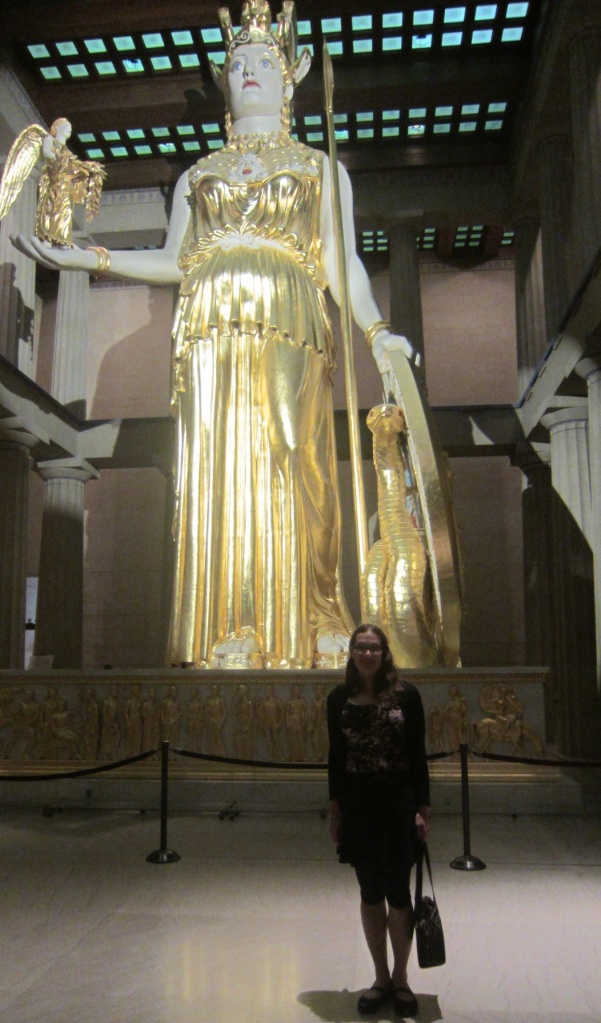
After completion of the 5th-century BCE Parthenon, ancient writers suggest it was primarily used as the Athenian city treasury rather than as a sacred space for worship of the Goddess. Pericles, a leading politician of ancient Athens, even referrred to the gold plating on the Athena colossus as a reserve source of coinage metal (en.wikipedia.org/wiki/Parthenon). The Nashville Parthenon replica was built to educate modern Americans about the cultural and political ideals we inherited from the Greek city of Athens. Yet, the grand and radiant Athena inside the Parthenon can certainly represent many more ideals for 21st century Americans. As Vanderbilt University lies only two blocks to the southeast of the Nashville Parthenon, the modern Athena represents the pursuit of learning, free-inquiry, and artistic skill much as She did in the Greco-Roman world of old. Today, in 2014, Americans and other free peoples of the world face terrifying threats: the ISIL mass-murder cult in the Middle East, the heartbreaking suffering from the Ebola epidemic in Africa, and the possible resurgence of communism in Russia. Rembering our cultural heritage and the hardships overcome by our intellectual ancestors of Greece can be a great source of hope and strength during these troubled times.
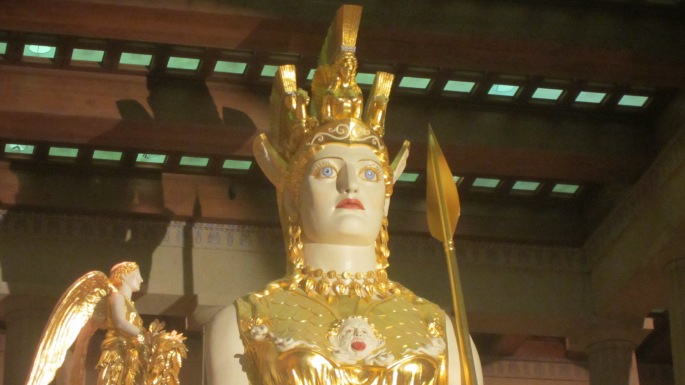
Monica and I then spent the afternoon strolling about the Music City District of downtown Nashville, twenty blocks to the northeast of Centenial Park. Though we are not avid fans of country music, the cultural heritage on display in record shops and the new traditions demonstrated by young street musicians impressed us both. Country music, along with gospel and southern rock, are uniquely American cultural treasures of which Nashville holds a great share.
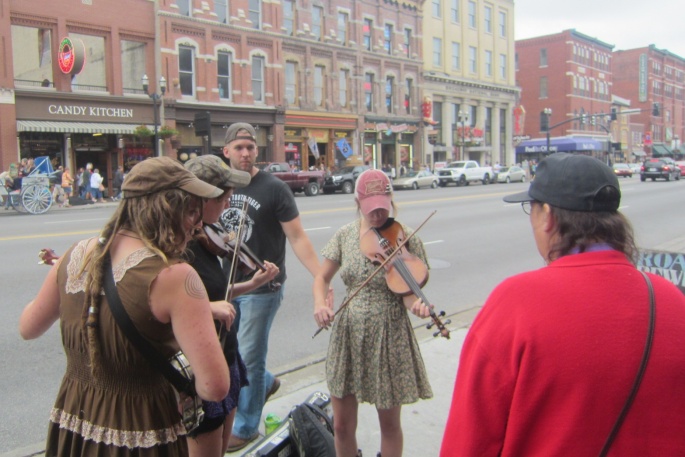
Finally, after sundown, Monica and I met up with the Tennessee Vals, a transgender support and education group. They were holding their monthly potluck in a church fellowship hall space. A great diversity of ethnic backgrounds and age groups were present. Some transwomen, as well as one vigourously outgoing Puerto Rican transman, were of the boomer generation. Several others were of my 30- to 50-something group. One 38-year-old recently transitioned femme I found quite attractive. I was especially impressed that she owns a web programming business while raising her four children. Another transwoman my age charmed me considerably with her smile, reddish-blonde hair, and freckles. There were also two teenage transwomen present, so delicately-featured that I assumed they were cis-women. I sensed no rivalries nor divisions among the forty or so people in attendance. In addition to the safe, therapeutic check-in session, the whole group had the feel of a close-knit family or small, progressive church community. Nashville appears to have a nurturing and vital trans community. Such contrasts with trans groups I’ve experienced in Atlanta, whether large meetings where hurtful comments and ideas go unchallenged, or small meetings which truly function as safe space, yet lack the membership base for effective outreach. In their mutual support and openness, our trans sisters and brothers of Nashville embody the “Athens of the South” as faithfully as the tall Athena in her Parthenon.

Thank you for very nice revue. But, err… You know, I guess it’s kinda nonsense even to imagine the resurgence of communism in my country (I live in Saint-Petersburg, RF). Unfortunately, the common mass-media (Russian, American, European, etc.) pretend to be honest and truthful but actually they are not (or “half-not”). It seems to be more plausible that our governments try to terrify people by telling stories about threats. As if some high-up representatives of our states commit a secret worship within the temple whilst gullible people just wait outside in doubts about the real purposes of their leaders. So now I stare at the Parthenon feeling the same. Hope our good sense won’t be dazzled by the brilliance of “Media-Goddess”.